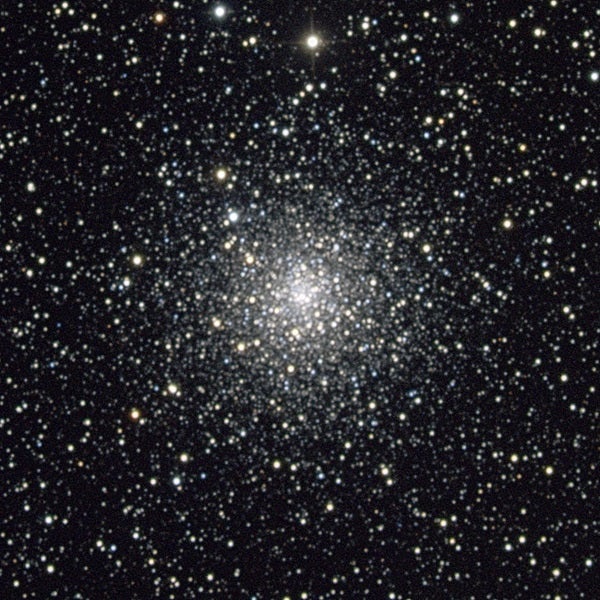How old are you? There’s a reason I’m asking. We’re going to look at your “Messier birthday object,” the one whose number matches your age. For example, I’ll turn 70 next month (no old-age comments, please) so my Messier birthday object will be M70, a globular star cluster in Sagittarius. Since I’m not yet 70, I still celebrate M69, another Sagittarius globular.
What about you? I’ll assume no baby or child genius reads this column, so we’ll skip the Crab Nebula (M1) and globular clusters M2 through M5, and begin with age 6. It corresponds to the beautiful open cluster M6 in Scorpius. Another stunning open cluster in the Scorpion, M7, follows. Up next are the Lagoon Nebula (M8) in Sagittarius, globular clusters M9 and M10 in Ophiuchus, the Wild Duck Cluster (M11) in Scutum, and a third Ophiuchus globular, M12.
You enter your teens with the fabulous globular cluster M13 in Hercules. Two more globulars follow (M14 in Ophiuchus and M15 in Pegasus), and then comes the iconic Eagle Nebula (M16) in Serpens and the Omega Nebula (M17) in Sagittarius. The teens close out with open cluster M18 in Sagittarius and another Ophiuchus globular, M19.
The 20s are the Sagittarius generation. Seven Messier objects, including the Trifid Nebula (M20), open clusters M21, M23, and M25, the spectacular globular cluster M22, the Sagittarius Star Cloud (M24), and faint globular cluster M28 reside in this constellation. The non-Sagittarius offerings are open clusters M26 in Scutum and M29 in Cygnus, and the Dumbbell Nebula (M27), a showpiece planetary in Vulpecula.
M30, a globular cluster in Capricornus, ushers in the 30s. It’s followed by a trio of galaxies: the Andromeda Galaxy (M31), its satellite M32, and M33 in neighboring Triangulum. After that, it’s all open clusters: M34 in Perseus, M35 in Gemini, M36, M37, and M38 in Auriga, and M39 in Cygnus.
The 40s open with disappointing M40, a faint double star in Ursa Major. After that, you run with open cluster M41 in Canis Major, the Orion Nebula and its fainter companion (M42 and M43), more open clusters (the Beehive [M44] in Cancer and the Pleiades [M45] in Taurus, M46 and M47 in Puppis, and M48 in Hydra), and wrap up with elliptical galaxy M49 in Virgo.
Those who reach the half-century mark start out with an open cluster in Monoceros (M50), the Whirlpool Galaxy (M51) in Canes Venatici, and open cluster M52 in Cassiopeia. Up next are globular clusters M53 in Coma Berenices, M54 and M55 in Sagittarius, and M56 in Lyra. Age 57 coincides with Lyra’s Ring Nebula. Your decade concludes, and the next one begins, with a three-galaxy lineup in Virgo that includes M58, M59, and M60.
The 60s offer five more galaxies, including M61 in Virgo, the Sunflower (M63) in Canes Venatici, the Black Eye (M64) in Coma Berenices, and side-by-side galaxies M65 and M66 in Leo. Three globular clusters (M62, M68, and M69 in Ophiuchus, Hydra, and Sagittarius, respectively) and open cluster M67 in Cancer complete the 60s.
I’ve already mentioned how my new decade will begin. M70 is followed by two more globulars, M71 in Sagitta and M72 in Aquarius. At age 73, you arrive at a four-star asterism in Aquarius (by “four-star,” I mean the number of stars it contains, not its rating). Your 74th birthday brings face-on galaxy M74 in Pisces. Up next is the Sagittarius globular M75, followed by the Little Dumbbell Nebula M76 in Perseus, M77 (a galaxy in Cetus), and the “other” emission nebula in Orion, M78. Globular cluster M79 in Lepus ends the 70s.
Octogenarians start out with M80, a globular cluster in Scorpius, before moving to the bright Ursa Major galaxies M81 and M82. The galaxy connection continues with M83 in Hydra and concludes with a sextet of galaxies (M84 through M89) in Virgo and Coma Berenices.
The 90s feature more Coma/Virgo galaxies (M90, M91, M98, and M99) as well as galaxies M94 in Canes Venatici and the side-by-side pair M95 and M96 in Leo. M92 (a beautiful globular cluster in Hercules), M93 (an open cluster in Puppis), and the Owl Nebula (M97) in Ursa Major provide variety.
As the Messier catalog winds down, so does the number of us still around to celebrate them as birthday objects. Galaxies once again dominate. They include M100 in Coma Berenices, M101, M108, and M109 in Ursa Major, M102 in Draco, the Sombrero Galaxy (M104) in Virgo, M105 in Leo, and M106 in Canes Venatici. An open cluster in Cassiopeia (M103) and an Ophiuchus globular (M107) complete our birthday object list. What if you live beyond 109? The whole Messier catalog is yours — you’ve earned it!
For a thorough look at the Messier catalog, refer to the database of the Students for the Exploration and Development of Space at messier.seds.org.
Questions, comments, or suggestions? Email me at gchaple@hotmail.com. Next month: The double star marathon revisited.











